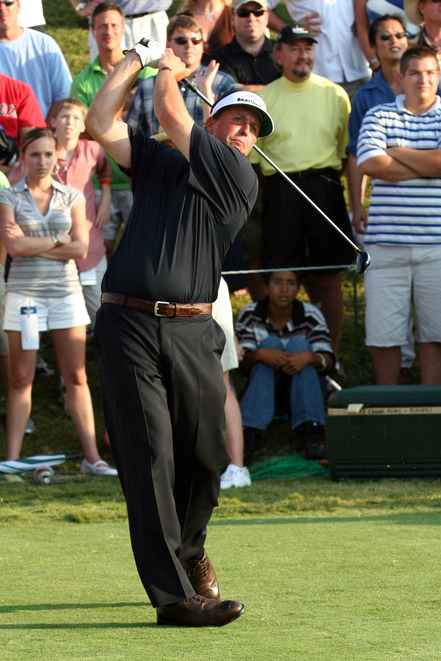TV charity matches may not rouse touring pros to perform with the intensity and drama they bring to a professional golf tournament, but made-for-TV events provide a better view of the courses they are being played on than the typical TV broadcast does. Even the annual telecast from Augusta National, with its permanent vantage points and iconic holes, never quite embeds viewers into the course from a player’s point of view.
The Masters' broadcast is great television, but as a passive viewer you may go from witnessing a stellar second shot to the green on the par five 2nd to a demoralizing tee shot on the wind-swirled 12th. Holding onto a sense of the relationships among the holes, understanding how each is oriented within the overall layout, is impossible when you’re jumping from hole to hole unless you’re already familiar with the routing, which few people outside of Augusta National members and touring pros are.
When Rory McIlroy, Dustin Johnson, Matthew Wolf and Rickie Fowler played Seminole in a fund raiser in 2020, viewers were able to see one of the world’s best courses in a way that even the finest typical TV broadcasts simply can’t provide. Because there was only a single foursome playing, viewers saw Seminole more or less seamlessly from the first tee to the 18th green. Aerial shots allow viewers familiar with studying the routing of courses on Google Earth, as golf architects often do, to appreciate Seminole’s overall layout.
Not long after the Seminole match, Tiger Woods, Phil Mickelson, Tom Brady and Peyton Manning teed it up at the Medalist Club, just up the road from Seminole. Built in a different era from Seminole, the Medalist Club’s course was unfamiliar to most golfers.
Pete Dye designed the Medalist Club course with Greg Norman. They met when Norman joined Old Marsh, a course Dye designed in the late 1980s. In Bury Me in a Pot Bunker, Dye said that his and Norman’s goal at Medalist was “to provide a distinctive look that is reminiscent of the old sandy hills at Pinehurst. Native grasses, including wire grass, a wispy species that never needs to be cut, will present the golfer with shot opportunities like those present on many Australian courses.”
In 2007, Golf Digest rated the Medalist as 12th among America’s 50 toughest courses, reprising the ranking scheme that evolved into its Top 100 list. Golf Digest wrote then that Dye’s “routing [was] overlaid by Greg Norman's architecture. No rough, just scrub pines and swamp. Lots of forced carries. Wayward drivers are gator bait.”
In 2013, Eamon Lynch reported that “Norman had an acrimonious and very public split from Medalist after the board hired Jacksonville Beach architect Bobby Weed to make changes to the course.” Notman called Weed’s hiring “a slap in the face.’”
Weed, one of Dye’s most successful protégés, noted that he had simply “restored the 1995 Dye layout in its entirety.”
Further imitating Dye by “living onsite during construction,” Weed said that his restoration emphasized “two cornerstones of the original design….revetted, stacked sod bunker faces and the nearly endless vistas over the surrounding freshwater marshes.”
Weed wanted “to recreate the flair and authenticity that only Pete could instill in a course.” Built on land similar to the wetlands Dye had to work with when he and Deane Beman created the TPC Sawgrass course near Jacksonville in the early 1980s, Medalist echoed the drainage and construction schemes Dye had pioneered at Sawgrass. Weed was the superintendent at Sawgrass before pivoting exclusively to golf design, first as in-house designer for the PGA Tour and later as the principal in his own firm. Weed acknowledges his "lifelong apprenticeship" to Dye.

Dye was also a member of Seminole, and one of the few contemporary architects willing to tinker with the work of Golden Age designers such as Donald Ross. I spent a week visiting Pete when he was building The Ocean Course on Kiawah Island before the great Ryder Cup matches of 1991. It was a revelation to watch him drop to the ground to create temporary scale models in the Kiawah sand to show his shapers what he wanted. He would often let the wind and water work the ground before grassing.
When he arranged for me to play Seminole the week after my Kiawah visit, Dye told me to pay particular attention to the famous Ross greens, to see if I could tease out the ways they too had evolved from accretions of sand and the effects of rain and wind. That he understood the reality of change occurring even on the most celebrated courses was an element of Dye’s famous irreverence and an enduring trait of his genius. He tinkered with his own courses, too, trying to keep up with the impact of better equipment and stronger, more skilled players on the nuances of his designs.
Watching two great professionals and a pair of modestly competent amateurs play The Medalist was a revealing look at Dye’s creativity from a player’s vantage point. It was also an chance to compare Dye’s Medalist layout with Ross’s work at Seminole—a pair of exemplary courses of their respective eras.